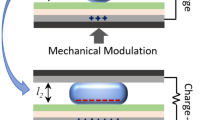Abstract
This study develops a driving system for an electrowetting-on-dielectric (EWOD) device comprising a 9 V battery, an ATmega8535 microprocessor, a DC/DC converter, two regulator ICs and a switch circuit. The driving system greatly improves the portability of the EWOD device and is capable of generating a square wave with voltages ranging from 50~100 Vpp and frequencies in the range 1~5 kHz. A series of experimental and numerical investigations are performed to investigate the effect of the conducting electrode geometry on the droplet velocity in the EWOD device. Three different electrode configurations are considered, namely a linear array of square electrodes, a series of interdigitated electrodes having either two or three fingers, and a series of interdigitated electrodes having five or six fingers. The experimental results show that the corresponding droplet velocities are 7.25 mm/s, 8.17 mm/s and 7.82 mm/s, respectively. The simulation results indicate that the pressure difference induced within the droplets actuated by the square, interdigitated (2323) and interdigitated (5656) electrodes has a value of 15.5 N/m2, 262 N/m2 and 141.1 N/m2, respectively. The corresponding droplet velocities are 33.8 mm/s, 72.7 mm/s and 64.5 mm/s, respectively. Overall, the experimental and numerical results indicate that the interdigitated (2323) electrode optimizes the transportation of the droplets in the EWOD device. The improved droplet velocity obtained using this particular electrode configuration is attributed to an increased length of the contact line between the droplet and the actuating electrode, which in turn increases the driving force.










Similar content being viewed by others
References
G. Beni, S. Hackwood, J.L. Jackel, Appl. Phys. Lett. 40(10), 912–914 (1982). doi:10.1063/1.92952
J. Berthier, P. Dubois, P. Clementz, P. Claustre, C. Peponnet, Y. Fouillet, Sens. Actuators A Phys. 134(2), 471–479 (2007). doi:10.1016/j.sna.2006.04.050
F. Cattaneo, K. Baldwin, S. Yang, T. Krupenkine, S. Ramachandran, J.A. Rogers, J. Microelectromech. Syst. 12(6), 907–912 (2003). doi:10.1109/JMEMS.2003.820285
D. Chatterjee, B. Hetayothin, A.R. Wheeler, D.J. King, R.L. Garrell, The Royal Society of Chemistry 2006, Lab Chip. 6, 199–206 (2006). doi:10.1039/b515566e
S.K. Cho, H. Moon, C.-J. Kim, J. Microelectromech. Syst. 12, 70–80 (2003). doi:10.1109/JMEMS.2002.807467
S.-K. Fan, Digital microfluidics cross-reference EWOD actuation: principle, device and system University in California Los Angeles Degree doctor of philosophy (2003)
S.-K. Fan, C. Hashi, C.-J. Kim, Proc. IEEE Conf. MEMS Jan. 694–697 (2003)
J. Gong, S.-K. Fan, C.-J. Kim, Proc. IEEE Conf. MEMS Jan. 355–358 (2004)
L.-S. Jang, G.-H. Lin, Y.-L. Lin, C.-Y. Hsu, W.-H. Kan, C.-H. Chen, Biomed. Microdevices. 9, 777–786 (2007). doi:10.1007/s10544-007-9089-8
J. Lee, C.-J. Kim, J. Microelectromech. Syst. 9(2), 171–180 (2000). doi:10.1109/84.846697
J. Lee, H. Moon, J. Fowler, T. Schoellhammer, C.-J. Kim, Sens. Actuators Phys. A. 95, 259–268 (2002). doi:10.1016/S0924-4247(01)00734-8
J. Lienemann, A. Greiner, J.G. Korvink, IEEE Trans. Comput.-Aided Design Integrat. Circuits Syst. 25(2), 234–247 (2006)
M.G. Lippman, Ann. Chim. Phys. 5, 494–459 (1875)
I. Moon, J. Kim, Sens. Actuators A. 130–131, 537–544 (2006). doi:10.1016/j.sna.2005.12.016
H. Moon, S.K. Cho, R.L. Garrell, C.-J. Kim, J. Appl. Phys. 92(7), 4080–4087 (2002). doi:10.1063/1.1504171
H. Ren, R.B. Fair, M.G. Pollack, Sens. Actuators B Chem. 98, 319–327 (2004). doi:10.1016/j.snb.2003.09.030
F. Rodes, EDN design ideas. 83–86 (2004)
T. Roques-Carmes, R.A. Hayes, B.J. Feenstra, L.J.M. Schlangen, J. Appl. Phys. 95(8), 4389–4396 (2004). doi:10.1063/1.1667595
V. Srinivasan, V.K. Pamula, M.G. Pollack, R.B. Fair, in IEEE 16th Annu. Int. Conf. MEMS. 327–330 (2003)
J. Zeng, T. Korsmeyer, Lab Chip. 4, 265–277 (2004). doi:10.1039/b403082f
Acknowledgements
This study was supported by the National Science Council of Taiwan under Grant No. NSC 95-2221-E-006-025. The authors would like to thank the Center for Micro/Nano Science and Technology and the National Nano Device Laboratories, both of Tainan, Taiwan, for their provision of technical support and the access provided to major items of equipment. Additionally, the authors gratefully acknowledge the support provided by the National Center for High-Performance Computing, Tainan, Taiwan, in performing the current CFD-ACE+ simulations. Finally, the authors wish to make it known that the current study made use of Shared Facilities supported by the Program of Top 100 Universities Advancement sponsored by the Ministry of Education, Taiwan.
Author information
Authors and Affiliations
Corresponding author
Rights and permissions
About this article
Cite this article
Jang, LS., Hsu, CY. & Chen, CH. Effect of electrode geometry on performance of EWOD device driven by battery-based system. Biomed Microdevices 11, 1029 (2009). https://doi.org/10.1007/s10544-009-9320-x
Published:
DOI: https://doi.org/10.1007/s10544-009-9320-x




